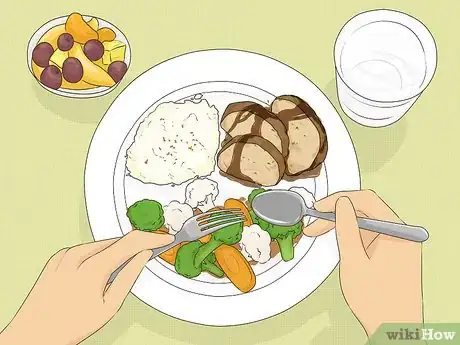This article was co-authored by Klare Heston, LCSW and by wikiHow staff writer, Danielle Blinka, MA, MPA. Klare Heston is a Licensed Independent Clinical Social Worker based in Cleveland, Ohio. With experience in academic counseling and clinical supervision, Klare received her Master of Social Work from the Virginia Commonwealth University in 1983. She also holds a 2-Year Post-Graduate Certificate from the Gestalt Institute of Cleveland, as well as certification in Family Therapy, Supervision, Mediation, and Trauma Recovery and Treatment (EMDR).
There are 13 references cited in this article, which can be found at the bottom of the page.
wikiHow marks an article as reader-approved once it receives enough positive feedback. In this case, 95% of readers who voted found the article helpful, earning it our reader-approved status.
This article has been viewed 279,480 times.
Struggles are a natural part of life, and sometimes staying upbeat throughout them can be a struggle. Luckily, happiness comes from the inside, and it’s possible to change for the better.[1] If you want to be a positive, happy, and optimistic person, start by creating the right mindset, then improve how you feel about your life and build good habits. Finally, practice self-care so that you can stay at your best!
Steps
Creating the Right Mindset
-
1Choose a mantra. A mantra helps you think more positively and cultivates a healthy mindset. When you're reciting your mantra, the part of your brain that makes self-judgmental thoughts turns off. You can use a mantra that you create for yourself, or you can choose a positive quote. Recite your mantra every morning or several times throughout the day. You can also post your mantra in your home, such as on your refrigerator, near your bathroom mirror, or on your wall.[2] Here are some examples of great mantras:
- “If I believe it, I can achieve it.”
- “Every day is a new beginning.”
- “I deserve love and happiness.”
-
2Use positive self-talk. You spend all day with yourself, so how you talk to yourself is important! Talk to yourself the same way you’d talk to your best friend. Make a point to say kind things to yourself. When you catch yourself saying something mean, switch it around to be positive.[3]
- For example, tell yourself, “I am capable,” “I am a hard worker who can achieve success,” or “I always do my best.”
- You may catch yourself in negative self-talk, such as, “I can’t do this. It’s too hard.” When this happens, don’t be mad at yourself. Instead, turn it around. Tell yourself, “It’s okay to be afraid when trying something new. This is an opportunity to learn, so I’m going to do my best.”
Advertisement -
3Confront your negative thought patterns. Negative thought patterns can prevent you from thinking positive, optimistic thoughts. You can fix them by noticing when you’re engaged in them and questioning your conclusions. Negative thought patterns include:[4]
- Filtering out positive experiences so that you focus on the negative.
- Personalizing negative events so that everything is your fault.
- Catastrophizing by assuming that the worst will happen.
- Polarizing every situation as either good or bad.
-
4Reframe difficult situations. You will encounter setbacks and obstacles in life, as that’s a normal part of living. How you approach them is important. Instead of dwelling on how they hurt you, try to see them in a more positive light by looking for something positive in the situation.[5]
- For example, you might be worried about trying something new. Instead of thinking, “What if I can’t do it?” tell yourself, “This is a great opportunity to try something new.”
- You don’t have to ignore negative feelings that you have about a hard situation. Instead, just look for opportunities for growth.
-
5Think about all of the things that could go right. Pessimistic people often dwell on their worries, constantly thinking about what could go wrong. However, you can change that mindset by looking for things that could go right. Over time, you can train your mind to think optimistically![6]
- When you catch yourself worrying, make a list of potential positive outcomes. You could write it down, list it in your head, or type it on your phone.
- At first, it might be hard not to think of things that can go wrong. When this happens, answer the negative thought with a positive thought. For example, you may think, “Group projects always end up with me doing all of the work but getting less credit.” Counter this thought with, “Group projects help all of us create our most innovative work.”
-
6Avoid labeling things as “good” or “bad.” Instead, think of everything as an opportunity. Humans aren’t born with a concept of “good” or “bad,” we learn it. You can change how you approach life by rejecting the labels you’ve learned.[7]
- For example, you might label a luxury apartment as “good” and a small studio apartment as “bad.” This can make you feel sad if you can only afford the studio. Challenge this label, focusing on why the studio is actually good, such as that it provides shelter.
-
7Spend more time thinking about the positive aspects of your life. When you spend more time thinking about something, your brain learns that it's a priority. While thinking about bad experiences can make you feel down, thinking about good experiences can make you feel positive and happy.[8]
- Look at photos that remind you of good memories.
- Post your favorite positivity quotes around your home so that you read them often.
- Review your gratitude journal.
-
8Make a gratitude list. Recognizing everything you have to be grateful for can help you foster a more positive mindset. No matter how bad things might seem, you do have things to be grateful for! Write down even the smallest details, such as sunny weather or a compliment from a stranger.[9]
- You could list everything in your life that you’re grateful for, or you could focus on just today.
- Try keeping a gratitude journal. For example, you might write down 5 things each day that you’re grateful for.
-
9Improve your sense of humor. A sense of humor helps you maintain a positive approach to life and laugh off minor hardships. For example, you might trip up at work or school. Instead of getting down on yourself, let your sense of humor help you laugh it off.[10]
- Smile
- Take a comedy class
- Watch funny movies
- Go to a stand-up comedy showcase
- Read humorous books
-
10Surround yourself with positive people. Just as negative people can bring you down, positive people can boost you up. Seek out friends that have a positive outlook on life, and limit the time you spend with overly negative people.[11]
- Don’t cut people out of your life for having a negative outlook, especially if they’re going through something. Instead, try to spend time with them in a group setting. Additionally, set boundaries so that you can be supportive without sacrificing your positive outlook.
- If you have a friend who is always negative, then you might try talking with them about it. Ask about their well-being and let them know you have noticed that they often seem unhappy.
Changing Your Approach to Life
-
1Find your purpose. Having a purpose in life can help you find happiness, as well as stay positive and optimistic. If you’re working toward your purpose, your successes have more meaning and your hardships won’t seem as difficult.[12]
- Journaling can help you find your purpose. Write your responses to questions like these:
- What do I want in life?
- What’s most important to me?
- Where do I see myself in 5 years? 10 years?
- What am I really good at?
- Consider how you enjoyed spending your time when you were growing up. This may connect to your purpose.
- Think about your personal beliefs. How could they give you purpose?
- Journaling can help you find your purpose. Write your responses to questions like these:
-
2Focus on changing one thing at a time. It’s normal to be dissatisfied with parts of your life. For example, you might not like your job, or you might be having a fight with a sibling. Confront one issue at a time to avoid becoming overwhelmed.[13]
- Make a list of what you want to change, then prioritize it. Start with what’s most important for you.
-
3Live in the moment using mindfulness. Much of what weighs on your mind comes from the past or the future. You can let go of these worries by living in the present. Focus on just this moment right now, allowing yourself to fully experience it.[14]
- Use your 5 senses to ground yourself in the moment. For example, smell the scents in the air, observe small details in the scene around you, and listen for the sounds you can pick out.
- Let go of distractions, such as your phone or earbuds.
-
4Let go of your need for control. It’s normal to want to control every aspect of your life, but that’s an impossible goal. Trying to control everything actually makes you more stressed and less happy. Instead of trying to control every aspect of your life, focus on controlling the only thing you can -- your own reaction.[15]
- Let other people take care of themselves.
- Don’t be afraid to delegate tasks.
- Remind yourself that you can’t eliminate difficult moments from your life, but you can approach them differently.
-
5Accept your circumstances for what they are. This may sound defeatist, but it’s actually the first step to improving your outlook. Don’t hold off on living because you’re waiting for the right circumstances. Your life is happening now![16]
- It’s okay to try to change your circumstances, as long as you focus on yourself and not others. You can change you, but not anyone else.
-
6Remind yourself that setbacks are temporary. You will encounter setbacks, as they happen to everyone. It’s easy to get tripped up by them, but don’t let them trap you in a mindset of defeat. Instead, view them as stepping stones on your path to success.[17]
- Tell yourself, “I have to fail to learn the lessons I need to be successful.”
Building Good Habits
-
1Do something you enjoy every day. This will boost your mood and give you a more positive outlook toward your life. It’s normal to spend much of your day taking care of work, school, or other responsibilities. Carve out time to make yourself happy, as well![18]
- Grab a coffee with a friend.
- Enjoy your hobby.
- Watch a favorite TV program.
- Play with your pet.
- Play a board game with family members.
- Eat dessert.
-
2Volunteer to help others. This helps you feel better about yourself and gives you a more positive perspective about your life. Not only will you be doing good, but volunteering also gives you a sense of abundance in your life. Choose a cause that you care about, then do something to help![19]
- Give your time at a local nonprofit. For example, you could hand out food at the local food bank.
- Donate your time to help a cause you care about, such as animal rights.
- You could also donate to charity.
-
3Do random acts of kindness. As the saying goes, “Giving is better than receiving.” Doing nice things for others will make you feel happy and positive. You’ll feel good about yourself and know that you’re helping create a better society.[20]
- Buy someone a coffee.
- Give a compliment.
- Treat a coworker to lunch.
- Make your family a special treat.
- Leave a favorite book on a bus seat or park bench.
- Post a kind note on the bathroom mirror.
-
4Schedule downtime so that you get proper rest. Rest is essential to living a happy life. It helps you stay positive, be more creative, and be more productive during your work times. Allow yourself to relax for at least 30 minutes each day, and give yourself 1 day each week to rest.[21]
- Give yourself permission to rest and relax. Don’t think about work or responsibilities during this time.
-
5Limit how much television you watch. This will give you more time to work on things that truly matter to you, such as your hobbies or personal goals. There’s nothing wrong with enjoying television, but too much of it can leave you feeling down. Turn off the tube and engage in an activity that supports your happy, positive life instead.
- Work toward a personal goal.
- Spend time with people you care about.
- Go to a museum.
- Check out a new place in your city.
Practicing Self Care
-
1Eat a nutritious, balanced diet. Nourish your body with the food that you eat so that you can live your best life possible. Not only will this help you look and feel your best, but it also helps you manage stress.[22]
- Eat plenty of fruits and vegetables, but limit simple sugars and processed foods.
- Drink at least 8 glasses of water each day.
- Don’t overly restrict your diet. Instead, focus on adding nutrition.
-
2Make a stress tool-kit. This can help you better cope with life’s stressors. Stress is a part of life, and having positive coping strategies ready can help you stay in a positive mindset. Here are some things you could include in your stress tool-kit:
- Bath salt in a calming scent, such as lavender
- A book of positive quotes
- A journal
- A bottle of essential oil in a scent you like
- Supplies for a favorite hobby
- Your favorite comedy flick
- An adult coloring book and colored pencils
-
3Set boundaries to protect your mental health. It’s easy to get overwhelmed, and it’s up to you to limit how much time and energy you expend on a daily basis. Give yourself limits, and communicate them to the people in your life.
- Let people know what you will and won’t tolerate. For example, tell your friends that you will turn off your phone at 10:00 p.m. so that you can rest.
- Say “no” when you don’t think something is right for you. It’s normal to not have the time, energy, or desire to want to do everything you’re asked to do.[23]
-
4Exercise for at least 30 minutes a day. You can do this in 1 block or break it up into 3 blocks of 10 minutes. This will boost your mood and reduce stress. For best results, choose an exercise that you enjoy.[24] Here are some great options:
- Go for a nature walk.
- Jog.
- Join a cardio class.
- Try an aerobics DVD.
- Dance.
- Participate in recreational sports.
-
5Perform breathing exercises. Breathing exercises can help you calm down and support a positive mind-state. If you want to relax, try a basic breathing exercise like the following:
- Keep it simple by just watching your breath. Focus your attention on each inhale and exhale, free of judgement.
- Breathe in for 4 counts, then hold your breath for 4 counts. Slowly release the air for 4 counts. Next, repeat these steps for a 6 count, followed by an 8 count.
- Sit comfortably in a quiet room. Visualize yourself in a happy place, such as the beach. Monitor your breath for 5-10 minutes.
- Try breathing in through your nose and out of your mouth. Take slow, deep breaths from your abdomen.[25]
-
6Meditate. Meditation is a great way to calm your mind and reduce stress. This can help you support your positive, happy mindset. Even 5 minutes of meditation can be helpful![26]
- You can use a guided meditation or just focus on your breath.
- Look online for meditation videos or try an app like Calm, Headspace, or Insight Meditation.
-
7Do yoga. Yoga helps you relax and connect with your breath. It can also improve your body image. You could try a sequenced yoga practice or just a few poses, depending on your preferences.[27]
- You can do yoga at home using a website, book, or DVD.
- Taking a yoga class at a local studio or gym can ensure that you are using proper form. It’s also a great way to deepen your practice and connect with other people.
-
8Get enough sleep. Sleep is important for your body, allowing it to repair itself. Unfortunately, it’s hard to get enough sleep.[28] How much sleep you need each night depends on your age:[29]
- Adults need 7-9 hours
- Teens need 8-10 hours
- School-aged children need 9-12 hours
- Young children need 11-14 hours
- Babies need 12-17 hours
Expert Q&A
Did you know you can get expert answers for this article?
Unlock expert answers by supporting wikiHow
-
QuestionHow can I stop expecting bad things to happen?
 Klare Heston, LCSWKlare Heston is a Licensed Independent Clinical Social Worker based in Cleveland, Ohio. With experience in academic counseling and clinical supervision, Klare received her Master of Social Work from the Virginia Commonwealth University in 1983. She also holds a 2-Year Post-Graduate Certificate from the Gestalt Institute of Cleveland, as well as certification in Family Therapy, Supervision, Mediation, and Trauma Recovery and Treatment (EMDR).
Klare Heston, LCSWKlare Heston is a Licensed Independent Clinical Social Worker based in Cleveland, Ohio. With experience in academic counseling and clinical supervision, Klare received her Master of Social Work from the Virginia Commonwealth University in 1983. She also holds a 2-Year Post-Graduate Certificate from the Gestalt Institute of Cleveland, as well as certification in Family Therapy, Supervision, Mediation, and Trauma Recovery and Treatment (EMDR).
Licensed Social Worker
Warnings
- Although being optimistic is great, you should also be realistic. Otherwise, you may not make decisions that are grounded in reality.⧼thumbs_response⧽
- Make sure that you give yourself plenty of time to grieve when you experience loss or other difficult things in your life.⧼thumbs_response⧽
References
- ↑ https://www.psychologytoday.com/us/blog/meditation-modern-life/201609/happiness-comes-within
- ↑ https://www.psychologytoday.com/us/blog/women-s-mental-health-matters/201604/5-ways-stop-your-racing-thoughts
- ↑ https://www.mayoclinic.org/healthy-lifestyle/stress-management/in-depth/positive-thinking/art-20043950
- ↑ https://www.mayoclinic.org/healthy-lifestyle/stress-management/in-depth/positive-thinking/art-20043950
- ↑ https://www.psychologytoday.com/us/blog/prime-your-gray-cells/201108/happy-brain-happy-life
- ↑ https://www.mayoclinic.org/healthy-lifestyle/stress-management/in-depth/positive-thinking/art-20043950
- ↑ https://www.psychologytoday.com/us/blog/meditation-modern-life/201609/happiness-comes-within
- ↑ https://www.psychologytoday.com/us/blog/prime-your-gray-cells/201108/happy-brain-happy-life
- ↑ https://www.helpguide.org/articles/stress/stress-management.htm
- ↑ https://www.mayoclinic.org/healthy-lifestyle/stress-management/in-depth/positive-thinking/art-20043950
- ↑ https://www.mayoclinic.org/healthy-lifestyle/stress-management/in-depth/positive-thinking/art-20043950
- ↑ http://www.businessinsider.com/emily-esfehani-smith-finding-meaning-life-4-pillars-2017-9
- ↑ https://www.mayoclinic.org/healthy-lifestyle/stress-management/in-depth/positive-thinking/art-20043950
- ↑ https://www.hsph.harvard.edu/news/magazine/happiness-stress-heart-disease/
- ↑ https://www.psychologytoday.com/us/blog/meditation-modern-life/201609/happiness-comes-within
- ↑ https://www.psychologytoday.com/us/blog/meditation-modern-life/201609/happiness-comes-within
- ↑ https://www.psychologytoday.com/us/blog/prime-your-gray-cells/201108/happy-brain-happy-life
- ↑ https://www.helpguide.org/articles/stress/stress-management.htm
- ↑ https://www.mentalhealth.org.uk/publications/doing-good-does-you-good
- ↑ https://www.mentalhealth.org.uk/publications/doing-good-does-you-good
- ↑ https://www.scientificamerican.com/article/mental-downtime/
- ↑ https://www.helpguide.org/articles/stress/stress-management.htm
- ↑ https://www.helpguide.org/articles/stress/stress-management.htm
- ↑ https://www.mayoclinic.org/healthy-lifestyle/stress-management/in-depth/positive-thinking/art-20043950
- ↑ https://www.helpguide.org/articles/stress/relaxation-techniques-for-stress-relief.htm
- ↑ http://www.apa.org/helpcenter/manage-stress.aspx
- ↑ https://www.webmd.com/balance/guide/tips-to-control-stress#1
- ↑ https://www.webmd.com/balance/guide/tips-to-control-stress#1
- ↑ https://www.cdc.gov/sleep/about_sleep/how_much_sleep.html
About This Article
By changing your perspective of negative situations and being more present in each moment, you can become more happy, positive, and optimistic. Try to avoid viewing things as good or bad, since often situations you think are bad make you stronger and turn into valuable learning experiences. Aim to be more mindful by paying attention to your senses in each moment rather than getting lost in thoughts about the past or worrying about the future. When you feel down, focus on trying to make other people happy, which will in turn make you feel good. For example, compliment your coworkers or buy a coffee for the person behind you in the line. If you find yourself feeling anxious or disheartened, tell yourself positive mantras, like, “I’m stronger than this,” or “I’m going to kick today’s butt.” For more tips from our co-author, including how to de-stress at the end of the day, read on!




























































































